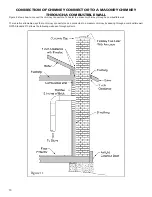
16
A draft reading of .05 to .06 w.c. is suggested for proper burning of this unit when using bituminous
coal as fuel. When using anthracite coal, this draft reading is a minimum reading.
CAUTION
A chimney fire may cause ignition of wall studs or rafters which you thought were a safe distance from
the chimney. If you have a chimney fire, have your chimney inspected by a qualified person before
using again.
EFFICIENCIES
Efficiencies can be based on either the lower heating value
(LHV) or the higher heating value (HHV) of the fuel. The lower
heating value is when water leaves the combustion process
as a vapor. The higher heating value is when water leaves
the combustion process completely condensed.
OVER FIRING
Attempts to achieve heat output rates that exceed heater design
specifications can result in permanent damage to the heater.
ASH REMOVAL AND DISPOSAL
Whenever ashes get 3 to 4 inches deep in your firebox or ash
pan, and when the fire has burned down and cooled, remove
excess ashes. Leave an ash bed approximately 1 inch deep
on the firebox bottom to help maintain a hot charcoal bed.
Ashes should be placed in a metal container with a tight-
fitting lid. The closed container of ashes should be placed
on a noncombustible floor or on the ground, away from all
combustible materials, pending final disposal. The ashes
should be retained in the closed container until all cinders
have thoroughly cooled.
SMOKE AND CO MONITORS
CO is a poisonous gas when exposed to elevated concentrations
for extended periods of time. While the modern combustion
systems in heaters drastically reduce the amount of CO emitted
out the chimney, exposure to the gases in closed or confined
areas can be dangerous. Make sure your stove gaskets and
chimney joints are in good working order and sealing properly
to ensure unintended exposure. It is recommended that you
use both smoke and CO monitors in areas having the potential
to generate CO.
GASKETS
It is recommended that you change the door gasket (which
makes your stove door air tight) once a year, in order to
insure good control over the combustion, maximum efficiency
and security. To change the door gasket, simply remove the
damaged one. Carefully clean the available gasket groove,
apply a high temperature silicone sold for this purpose, and
install the new gasket. You may light up your stove again
approximately 24 hours after having completed this operation.
This unit’s ash door uses a 5/8" diameter rope gasket. This
unit's feed door uses a 1/2" diameter rope gasket.
SERVICE HINTS
Do not expect a furnace to draw. It is the chimney that
creates the draft. Smoke spillage into the house or
excessive build-up of water or creosote in the chimney
are warnings that the chimney is not functioning properly.
Correct the problem before using furnace. Possible causes are:
1.
The connector pipe may be pushed into the chimney too
far, stopping the draft.
2.
Do not connect two furnaces or a stove and furnace into
the same chimney flue.
3.
The chimney used for a furnace must not be used to
ventilate the cellar or basement. If there is a cleanout
opening at the base of the chimney, it must be closed tightly.
4. If the chimney is operating too cool, water will condense
in the chimney and run back into the furnace. Creosote
formation will be rapid and may block the chimney. Operate
the furnace at a high enough fire to keep the chimney
warm, preventing this condensation.
5.
If the fire burns well, but sometimes smokes or burns
slowly, it may be caused by the chimney top being lower
than another part of the house or a nearby tree. The
wind blowing over a house or a tree, falls on top of the
chimney like water over a dam, beating down the smoke.
The top of the chimney should be at least 3 feet above
the roof and be at least 2 feet higher than any point of
the roof within 10 feet.
CHIMNEY MAINTENANCE
Creosote and Soot - Formation and Need for Removal
When coal is burned, the products of combustion combine with
moisture to form a soot residue which accumulates on the flue
lining. When ignited, this soot makes an extremely hot fire.
The chimney should be inspected at least twice monthly
during the heating season to determine if a creosote or soot
build up has occurred.
If creosote or soot has accumulated, it should be removed to
reduce the risk of a chimney fire.
Chimney fires burn very hot. If the chimney catches fire,
immediately call the fire department, then reduce the fire by
closing the inlet air control. Pour a large quantity of coarse
salt, baking soda or cool ashes on top of the fire in the firebox.
ATTENTION:
This heater needs periodic inspection and repair for proper operation. It is against federal regulations
to operate this heater in a manner inconsistent with operating instructions in this manual.
Summary of Contents for 1357M
Page 6: ...6 Figure 2 Model 1557M Figure 1 Model 1357M DIMENSIONS OF FURNACE ...
Page 23: ...23 CENTRAL INSTALLATION CENTRAL INSTALLATION ADD ON INSTALLATION ...
Page 25: ...25 INSTALLATION D INSTALLATION E ...
Page 26: ...26 INSTALLATION F INSTALLATION G ...
Page 27: ...27 INSTALLATION H TOP VIEW FRONT VIEW ...
Page 30: ...30 NOTES ...
Page 31: ...31 NOTES ...
















































